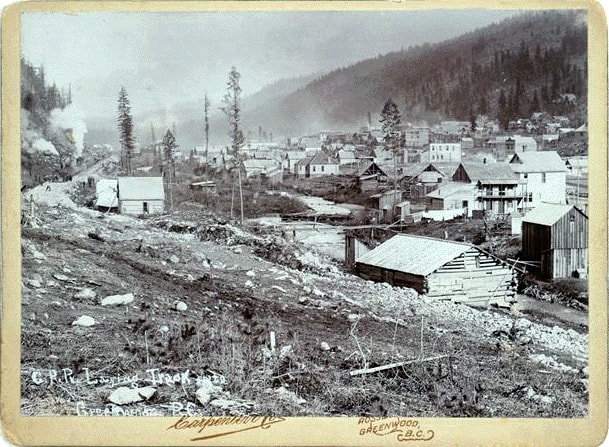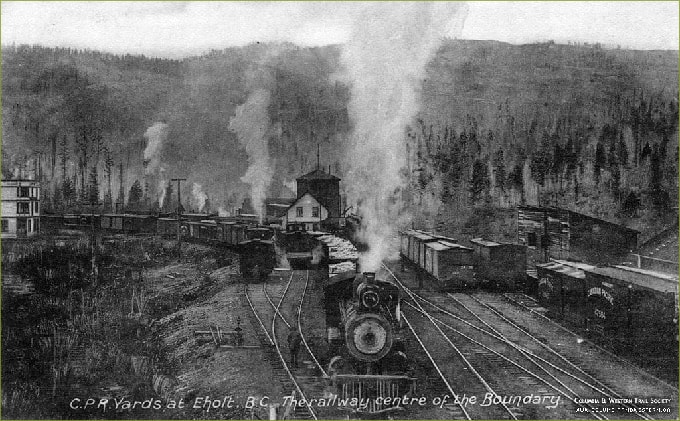Riding the Rails to Greenwood
BY: BG EDITOR

Trains at the Mother Lode Mine near Greenwood, c. 1903
[ Photo: Wm. Notman & Son, McCord Museum, V3684, Creative Commons ]
Feb 04, 2017 — GREENWOOD, BC (BG)
As described in the book, Steam Along the Boundary[1], "The interplay of mines, smelters and railways set the stage in the Boundary District for a 20-year mining boom that shaped the formative years of many cities and communities, some now all but forgotten, along the British Columbia-Washington border."
The photograph above, taken by Wm. Notman & Son, shows the Canadian Pacific Railway's Locomotive No. 952, a 2-8-0, built in 1896. This engine was first run on the Field Hill in the Rockies. However, due to the demands put upon trains here in the Boundary, where engines had to progress up steep grades on branch lines to the mines, the Canadian Pacific deployed some of their newest locomotives to the Boundary District in the early 1900s.
C.P.R. engine No. 952, sitting at the Mother Lode Mine near Greenwood, was eventually retired from service on the Esquimalt & Nanaimo line on Vancouver Island in the early 1930's. (By then, re-numbered to No. 3131.)
In our recent segment on historic photographers, we mentioned cameramen William Jefferson Carpenter and George Edward Millar of Carpenter & Co., who took the following photo — a beautiful panoramic shot of Greenwood in the early 1900's, when the Canadian Pacific was laying track.

"C.P.R. Laying Track into Greenwood, B.C."
[ Photo: Gelatin silver print by Carpenter & Co. Rossland, Greenwood, B.C. ]
The Canadian Pacific Railway was not the only railroad steaming around Greenwood in the early years. The Great Northern Railway, a Class 1 American railroad running from St. Paul, Minnesota to Seattle, Washington, pushed a line through from Grand Forks to Phoenix Mountain. Once the Phoenix area proved to be a rich field, the GNR hoped to compete on Canadian soil with our own CPR.
There was also the Columbia & Western Railway, owned by CPR, which reached Greenwood from the east by 1899. Following is a brief summary of the history of the C&W[2] in southern B.C. and the Boundary:
RAILWAY CONSTRUCTION CASTLEGAR TO MIDWAY:
"In 1890 gold and copper were discovered near Rossland. The Columbia and Western Railway (C&W) was charted to run from the smelter in Trail to Penticton. This line was completed to Robson West in 1897. The C&W from Rossland to Trail was a narrow gauge railway to the smelter at Trail. On April 2, 1898 surveyors led by a man named Rice reached Grand Forks with slashing crews following close behind them. By September 24, six railroad construction camps between Cascade and Grand Forks employed 250 men. A portable sawmill, operated by McPherson and Stout, supplied rail ties and timbers and W.H. Fisher supplied 70,000 rail ties from a site north of Niagara. The Columbia and Western Railway was purchased from mining developer Fritz Heinze, along with the trail smelter by CPR in 1898.
The Boundary country ore (from the City of Paris Mine) was delivered to the Trail smelter. On November 25, 1899 passenger service extended to Greenwood. By 1900 the railroad had reached Midway with a branch line from Eholt to the copper-rich area of Phoenix. Construction of this railroad required great effort and was often times extremely dangerous. On January 11, 1900 two men were killed by flying rock. On February 4, 1900, 100 men were sent out to shovel drifts. By reaching the Boundary District, the CPR had scored a major victory against its American railroad competitors in its bid to re-establish Canadian control in southern British Columbia. American communities along the Kettle River and tributary valleys south of the international boundary found it easier to ship via CPR than to use the long and rough wagon roads leading to J.J. Hill's Great Northern (GN) railroad in Washington State.

"C.P.R. Yards at Eholt, B.C., the Railway Centre of the Boundary"
[ Photo: Canada & Western Trail Society, www.columbiaandwestern.ca ]
CONSTRUCTION OF SPUR FROM GREENWOOD TO MOTHER LODE:
A branch line was constructed by the CPR from Greenwood to Deadwood Camp and the Mother Lode Mine during 1900. Also called the Deadwood Spur, the line opened the copper-rich Deadwood Ridge area for mining development. The B.C. Copper Company Smelter was completed in 1901 on the spur above Greenwood and shortly thereafter employed 400 men. The company built a smelter at Grand Forks that, in 1900, was connected to the mines at Phoenix by a branch of the CPR. The first ore was shipped in July of that year and the smelter blown in on August 21. By 1905 more than 1,995,800 tonnes of ore had been shipped and the Granby smelter became the largest copper smelter in the British Empire and the second largest in the world. In 1910 most of the ore bodies at Phoenix were under control of the Granby Company. However some remained in the hands of the B.C. Copper Company and the New Dominion Copper Company which shipped ore to their smelters at Greenwood and Boundary Falls."
The arrival of the Canadian Pacific Railway in growing enclaves like Greenwood was cause for great celebration, as was completion of the heavy equipment and infrastructure that supported getting the Boundary's ore to the railcars. One such scene at Phoenix is described in this passage from a 1900 edition of The Greenwood Times[3]:
"Amid the shrieking of whistles and cheers of the assembled miners and other citizens of Phoenix and with the ore bunkers gaily decorated with flags the last piece of steel was laid to the old Ironsides ore bins at noon today. Immediately after the last spike was driven the deep basso-profundo whistle of the Ironsides shaft house heralded the welcome news quickly followed by the Knob Hill and in turn taken up by the War Eagle, Gold Drop, Golden Crown and other mines. The terrible earsplitting din was not lessened by numerous explosions of dynamite and C.P.R. locomotive whistles."

Wooden Trestle over Boundary Creek
[ Photo: Robert Turner Collection, Greenwood Museum ]
Here in Greenwood, the great wooden trestle that once carried Canadian Pacific Railway trains over the Boundary Creek is now also a memory. In the picture above, a passenger train is crossing over the long trestle, built in 1899. The structure was replaced in 1913 with a large fill of gravel. A concrete-lined one-lane tunnel carried the road under the gravel fill, so cars could continue to move through. In 1964 it was replaced with a two-lane tunnel, known today as Greenwood's Flag Tunnel.
Trains hold a certain fascination for those who love the history of this place. Raw materials, people, and the community spirit of the entire Boundary region rode on these rails. The thrill of traveling across land to Greenwood in the early days is well spoken in this narration from The Kootenanian, December 1899[4]:
"The trip from Kaslo to Greenwood was one of grandeur unexcelled. From the long sloping hills around Robson to the sharp peaks at Phoenix one would hardly think that the ingenuity of man could accomplish so much in a few months… From Robson to the Summit is a steady climb of many feet and as you go through a tunnel — of which there are many — and onto a high trestle, it almost takes your breath away. …At the summit there are nine switchbacks of half a mile each going up, and the same on the other side coming down. It takes two hours to go through all this maneuvering and then you start on the way to the famous Boundary Country."
FOOTNOTES:
[1] Steam Along the Boundary, Robert D. Turner and J. S. David Wilkie, 2007
[2] History of the Columbia & Western Railway:
www.columbiaandwestern.ca
Railway Milepost: British Columbia, Vol. II by Roger Burrows
"The Crow and the Kettle" by John Garden
Cycling the Kettle Valley Railway, Vol. III by Dan Langford
[3] The Greenwood Times — May 23, 1900
[4] The Kootenanian (Kaslo) — December 14, 1899








